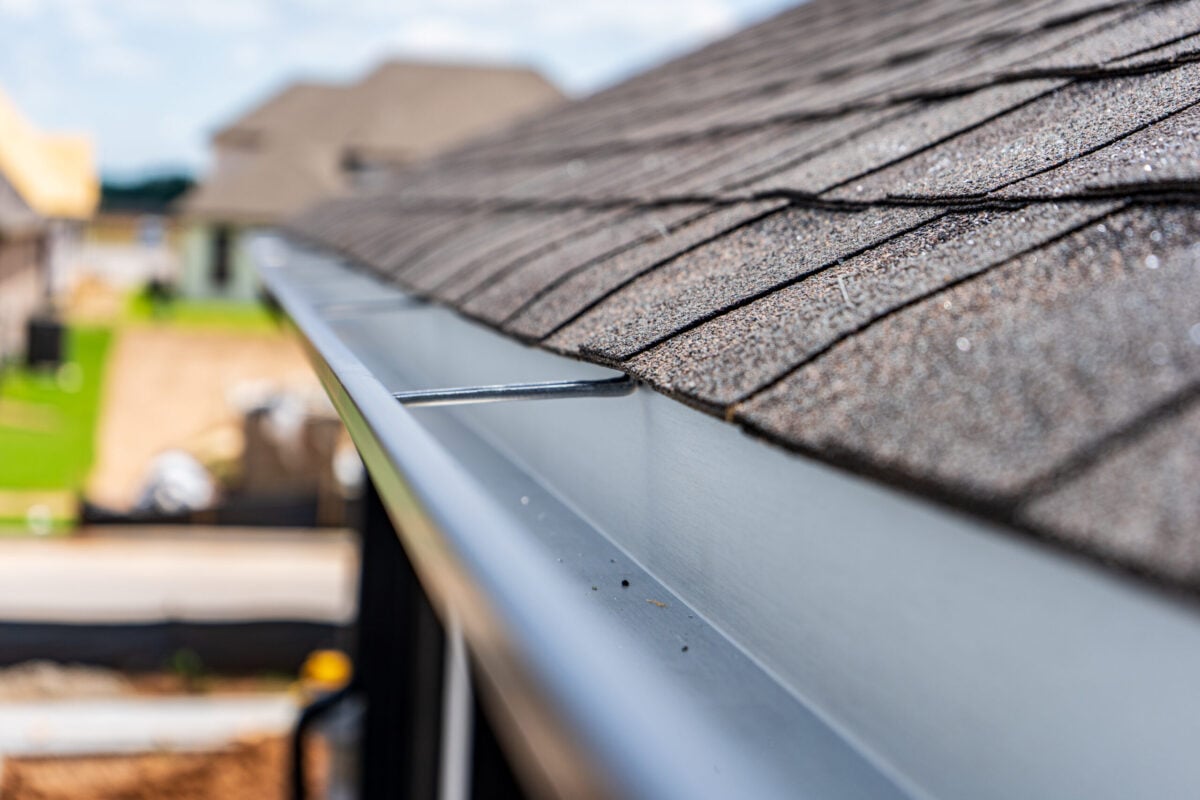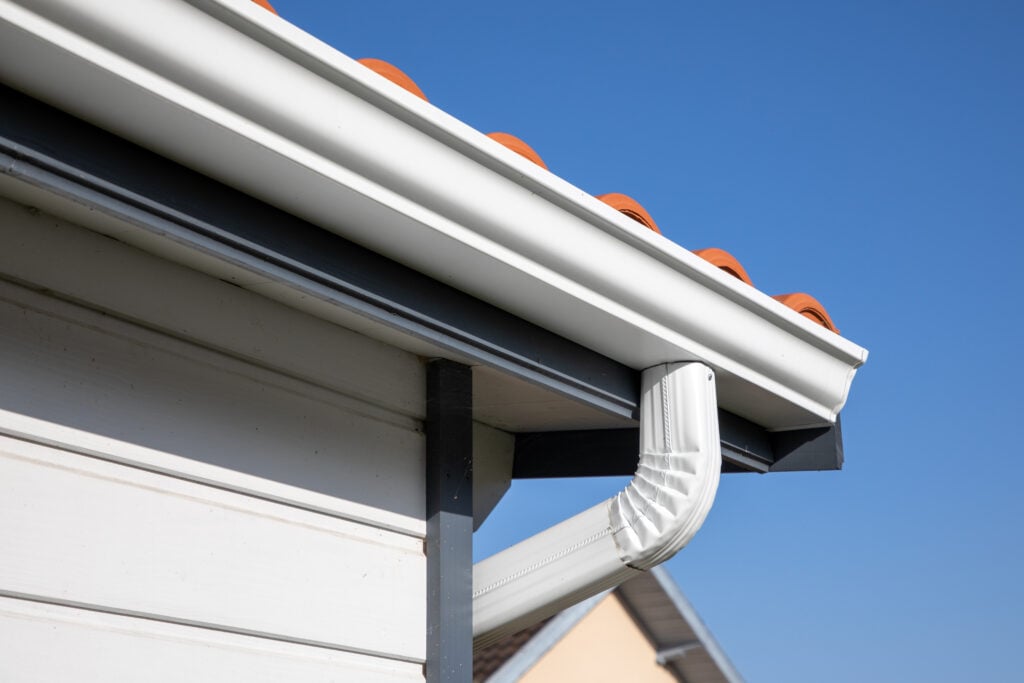
5 Standard Gutter Sizes for Your Roof Drainage System (2025)
07.08.2025
9 Min Read
Selecting the right gutter sizes for your home is one of the most important decisions you’ll make for your roof drainage system. The wrong size can lead to water damage, foundation issues, and costly repairs down the road. The right size protects your investment and keeps your home safe from water-related problems.
This comprehensive guide covers everything you need to know about gutter sizes, from standard dimensions to factors that influence your choice. You’ll learn how to calculate the right size for your home, understand different gutter profiles, and discover when to call in the professionals.
Here’s what we’ll cover:
- Understanding standard gutter sizes and their applications
- Key factors that determine the right gutter size for your home
- How to calculate gutter capacity based on roof area and rainfall
- Different gutter profiles and their size variations
- Installation considerations that affect gutter performance
❗️ Understanding Standard Residential Gutter Sizes

Most residential properties use gutters that fall into three main size categories. Each serves different home types and drainage requirements.
Five-inch gutters are the standard choice for most residential applications, offering a cost-effective, widely available solution for homes with roofs up to 5,500 square feet in areas with typical rainfall. For homes needing greater capacity, such as larger properties, steep roofs, or regions with heavy rainfall, 6-inch gutters provide enhanced water-carrying ability, handling roofs up to 7,900 square feet effectively, though they come with higher costs. On the other hand, 4-inch gutters, while less common, are still used for specialty applications like smaller structures (sheds or garages) or older homes where aesthetics or limited roof areas call for smaller systems.
Key Factors That Determine Your Ideal Gutter Size
Several important factors influence which gutter size will work best for your specific situation. Understanding these elements helps ensure optimal performance from your drainage system.
- Roof Area and Pitch: The total square footage and pitch of your roof determine the water volume your gutters must handle. Steeper roofs create faster water flow, requiring higher-capacity gutters. Low-sloped or flat roofs, on the other hand, require a different approach to ensure proper drainage. Calculate the roof area by adjusting the footprint for pitch (e.g., a 6/12 pitch has a factor of 1.12).
- Local Climate and Rainfall: Heavy, intense rainfall requires larger gutters to handle the volume. Use rainfall intensity data from the National Weather Service to guide sizing. While 5-inch gutters may suffice for average rain, 6-inch systems offer better protection during downpours.
- Roof Design Complexity: Complex rooflines with valleys, dormers, and intersections channel more water to specific areas, often requiring larger gutters or additional downspouts. Simple roof designs distribute water evenly, making standard sizing more effective.
- Trees and Debris: Homes with heavy tree coverage face more debris and clogging risks. Larger gutters handle debris better, reduce maintenance, and are compatible with gutter guards for easier long-term care.
🔎 5 Standard Gutter Sizes for Your Roof Drainage System

Understanding the specific dimensions and applications of each standard gutter size helps you make an informed decision for your home’s drainage needs.
1. 4-Inch Gutters (Rare Residential Use)
- Dimensions: These gutters measure 4 inches wide and are typically 3 inches deep. They are smaller than standard residential gutters, making them a unique option for specific applications.
- Capacity: Despite their compact size, 4-inch gutters can handle runoff from up to 2,500 square feet of roof area, which is sufficient for smaller buildings or structures with limited roof coverage.
- Best for: Ideal for small structures like sheds, detached garages, or decorative accents on historic homes. They are also commonly used in restoration projects where maintaining the original aesthetic is critical.
- Cost: These are the cheapest option in terms of materials. However, their limited availability can make them harder to source, and installation may require specialized expertise in certain cases.
2. 5-Inch Gutters (Standard Residential)
- Dimensions: At 5 inches wide and typically 4 inches deep, these gutters strike the perfect balance for most residential properties. They are the standard size used in the majority of homes today.
- Capacity: 5-inch gutters can manage water runoff from up to 5,500 square feet of roof area, making them capable of handling moderate to heavy rainfall in most regions.
- Best for: Perfect for single-story and two-story homes in areas with average rainfall. They work well with most roof designs and are a reliable, economical choice for homeowners.
- Cost: Widely available and cost-effective, 5-inch gutters offer the best value for the average homeowner. Installation is straightforward, and materials are affordable and easy to source.
3. 6-Inch Gutters (Heavy-Duty Residential)
- Dimensions: With a width of 6 inches and a depth of 4-5 inches, these gutters are larger and more robust than the standard 5-inch option. They are designed to handle a greater volume of water.
- Capacity: These gutters can accommodate water runoff from up to 7,900 square feet of roof area, making them suitable for homes with large or steep roofs and areas with heavy rainfall.
- Best for: Best for large homes, multi-story houses, or properties with steep-pitched roofs where water runoff is significant. They are also an excellent choice for regions prone to intense storms and heavy downpours.
- Cost: While they have a higher upfront cost due to their size and material requirements, the performance benefits often outweigh the expense, especially in areas with extreme weather.
4. 7-Inch and 8-Inch Gutters (Commercial/Specialty)
- Dimensions: These oversized gutters measure 7 to 8 inches wide and can have depths exceeding 5 inches. They are designed for maximum water flow and durability in demanding conditions.
- Capacity: With the ability to handle massive amounts of water, these gutters are suitable for roofs covering very large residential properties or commercial buildings.
- Best for: Ideal for commercial roofing projects such as warehouses, office buildings, and schools. They are also used in areas that experience extreme weather conditions, like heavy snowfall or torrential rain.
- Cost: These gutters are custom-made and typically require professional installation due to their size and weight. The cost is higher than standard residential options, but their durability and performance make them worth the investment for large-scale applications.
5. Half-Round Gutters (Variable Sizing)
- Dimensions: Available in diameters of 5 inches and 6 inches, half-round gutters have a U-shaped design that makes them distinct from the more common K-style gutters.
- Capacity: While they have a slightly lower capacity than K-style gutters of the same width, their open design allows for smooth water flow and easier maintenance in many cases.
- Best for: These gutters are particularly suited for historic or architecturally unique homes where their classic design adds to the aesthetic appeal. They are often chosen for their timeless look and compatibility with traditional building styles.
- Cost: Half-round gutters are generally more expensive than standard K-style options due to their specialized design and limited availability. Installation may also cost more since they require specific brackets and mounting techniques.
Gutter Profile Types and Size Variations
Different gutter profiles offer varying capacities even within the same nominal size category. Understanding these differences helps optimize your drainage system performance.
K-Style Gutters
K-style gutters feature a decorative front edge that resembles crown molding. They’re the most popular choice for modern homes due to their attractive appearance and efficient water-carrying capacity.
The flat back allows for easy mounting against fascia boards, while the bottom shape maximizes water volume. K-style gutters typically hold about 40% more water than half-round gutters of the same width.
Half-Round Gutters
Half-round gutters offer a classic, traditional appearance that complements older architectural styles. While they carry less water than K-style gutters, they’re easier to clean and less prone to debris accumulation.
These gutters work well for homes where aesthetics take priority over maximum capacity. They’re also preferred for historic renovations where maintaining architectural authenticity is important.
Box Gutters
Box gutters are built into the roof structure rather than hanging from the edge. They’re typically custom-sized for specific applications and offer superior capacity for challenging drainage situations.
Professional design and installation are essential for box gutters due to their integration with the roof system. They’re most common on commercial buildings but occasionally used for residential applications.
👉 Calculating the Right Gutter Size for Your Home

Proper gutter sizing requires careful calculation based on your specific roof characteristics and local weather patterns. When correctly handled by experienced roofers, this process ensures adequate capacity for effective water management.
Measuring Your Roof Area
Start by calculating the total roof area that will drain into each gutter section. Measure the length and width of each roof plane, then multiply these dimensions to get square footage.
For pitched roofs, use the actual roof surface area rather than the building footprint. In that case, if you want to learn more about how to measure a roof for shingles, for example, you can find all the information on our website. You can then multiply the footprint area by the appropriate pitch factor: 1.05 for 4/12 pitch, 1.12 for 6/12 pitch, or 1.25 for 9/12 pitch.
Determining Rainfall Intensity
Check local weather data for maximum expected rainfall intensity, typically measured in inches per hour. Most areas use either a 10-year or 100-year storm intensity for gutter sizing calculations.
The National Weather Service provides this data through their precipitation frequency estimates. Higher intensity areas require larger gutters or more frequent downspouts to handle peak flows.
Applying the Gutter Sizing Formula
Use this formula to determine minimum gutter size: Roof Area × Rainfall Intensity × 0.623 = Required Gutter Capacity (gallons per minute).
Compare this result to manufacturer capacity ratings for different gutter sizes. Always round up to the next larger size to provide a safety margin for extreme weather events.
👨🔧 Trust the Experts at Barkley-Jensen for Your Gutter Needs
At Barkley-Jensen Roofing & Restoration, we understand that every North Carolina home has unique drainage requirements. Our team of roofers brings years of experience helping homeowners select and install gutter systems that handle our region’s challenging weather patterns. From initial assessment through final installation, we focus on delivering solutions that provide lasting protection for your property.
Ready to upgrade your home’s drainage system with properly sized gutters? Contact Barkley-Jensen Roofing & Restoration today for a comprehensive assessment and detailed proposal. Let our expertise guide you toward the perfect gutter solution for your North Carolina home.




